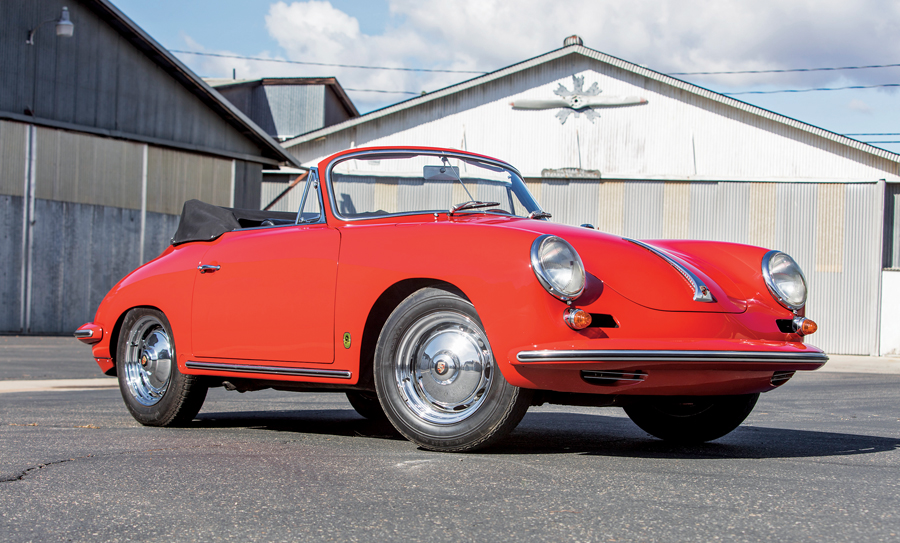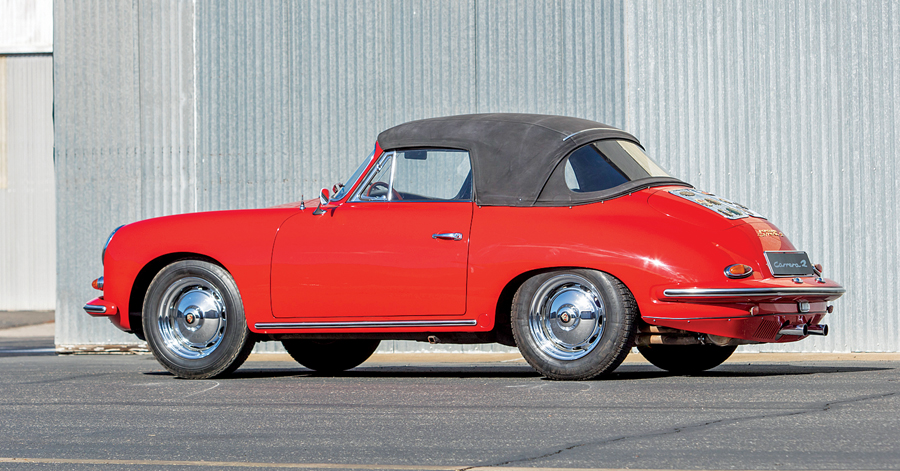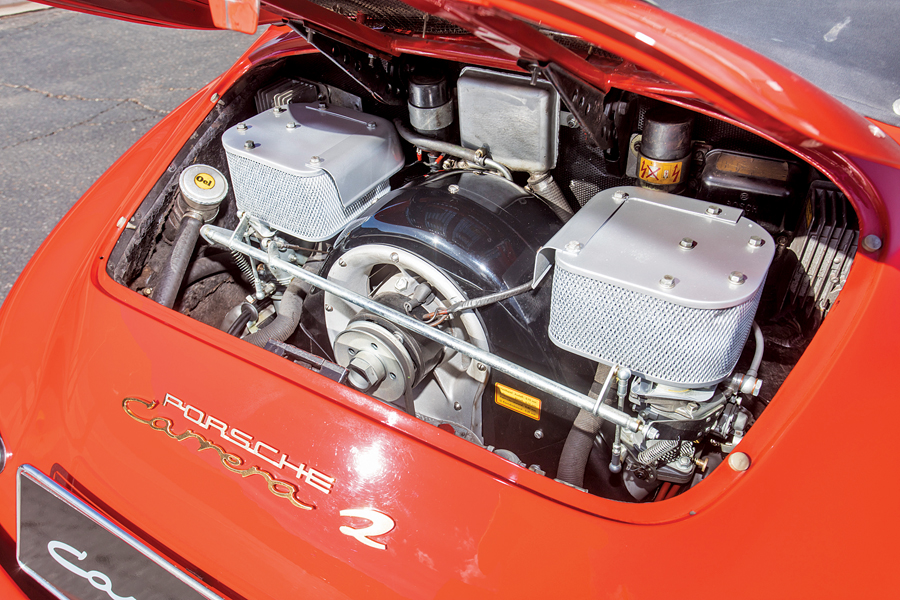- Coachwork by Reutter
- 1,966-cc DOHC flat 4-cylinder engine
- Dual Solex 40PII-4 downdraft carburetors
- 130 bhp at 6,200 rpm
- 4-speed manual transaxle
- Four-wheel independent suspension
- Four-wheel Annular disc brakes
- Selling after 30 years of single ownership
- Exquisite, highly original example of the top-of-the-line 356 Carrera 2
- Fully documented ownership history from new
SCM Analysis
Detailing
| Vehicle: | 1963 Porsche 356B Carrera 2 GS Cabriolet |
| Years Produced: | 1962–65 Carrera 2s |
| Number Produced: | 66 1962–63 356B Carrera 2s cabs; 96 total Carrera 2 cabs |
| Original List Price: | $6,212 according to the factory price list |
| SCM Valuation: | $550,000 |
| Tune Up Cost: | $6,000 with valve adjustment |
| Chassis Number Location: | Stamping in trunk, below gas tank; aluminum tag in trunk, aluminum tag on driver’s side A-pillar |
| Engine Number Location: | Punched boss on engine, low, facing rear |
| Club Info: | Porsche Club of America |
| Website: | http://www.pca.org |
| Alternatives: | 1962–64 Ferrari 250 GT/L Lusso, 1963–65 Aston Martin DB5, 1963–66 Alfa Giulia Sprint |
| Investment Grade: | A |
This car, Lot 88, sold for $1,000,500, including buyer’s premium, at Bonhams’ Scottsdale Auction at the Westin Kierland Resort in Scottsdale, AZ, on January 17, 2019.
Porsche built the first 356 in 1948. The first series competition 356 was built in 1952 — it was the aluminum-bodied “America Roadster,” reflecting its intended U.S. market for SCCA and Cal Club racing.
Porsche’s first purebred “prototype” race car, the Type 550 Spyder, was introduced in 1953.
Bred for competition
By the early 1950s, Porsche already knew that displacement, rpm and cooling limitations hindered their flat 4-cylinder pushrod in competition. A new engine project, internal number Type 547, was launched under the firm’s chief engine engineer, Ernst Fuhrmann. An Austrian, Fuhrmann graduated from the Vienna Technical Institute in 1938. He had written his dissertation on the design of camshaft trains in high-performance engines.
Fuhrmann joined Porsche while the firm was in its World War II-induced “exile” in Gmünd, Austria. Initially, he worked on the Cisitalia Type 360 Grand Prix race car. The design commission from this car paid the French for the release of Ferdinand Porsche from Dijon prison.
Start with 100 horsepower
Porsche wanted 100 horsepower per liter of displacement and at least 7,000 rpm from the new engine. Getting there would take full advantage of Fuhrmann’s skills. After only six months of development — including nights and weekends — the new engine emerged.
The engine was very complex. It was based on the best available high-rev crankshaft, the roller-bearing Hirth with an assembled multi-piece design. To directly activate the valves, Fuhrmann designed a bevy of gears and shafts to connect the four camshafts, two over each bank of cylinders — upper for intake valves and lower for exhaust. Tolerances were tight and assembly had to be precise.
Fuhrmann also employed dual-plug ignition and doubled air flow cooling versus the pushrod engines.
The new engine also fit into a 356
Fuhrmann designed the new 1,498-cc engine to be a tidy overall package, so it could fit into a production 356. Turns out Fuhrmann wanted to upgrade his company car. The Type 547 engine was first installed in 356s in 1954. Porsche then introduced these 356 “Carreras” to the public at the Frankfurt Auto Show in September 1955.
These Type 547 engines initially delivered 110 horsepower, ultimately building up to 180–185 horsepower for specialized racing use. The 4-cam engines in race cars ran strong and lasted well. The engine had more trouble when used on the street. Constant starts/stops and low-rev “lugging” led to crankshaft failures. That is still true today for roller-crank engines.
Moving to plain-bearing crankshafts
To remedy that weakness, Porsche moved to plain-bearing crankshafts with the Type 692/1 engines with 1,587 cc, which were introduced in 1959. For 1962, Porsche increased displacement to 1,966 cc with the Type 587, and the Carrera 2 was born.
Horsepower ranged from 130 with a redline at 7,000 rpm in street applications (Type 587/1), up to 180/185 horsepower and 8,000 rpm in 904/Elva-Porsche competition cars (Types 587/3 and 587/3A).
Great then, valuable now
Today, 4-cam Porsche race cars are very desirable and valuable: 550, 550A, RS60 and RS61 Spyders; Carrera Abarths; 904s; and a few special race cars. These cars trade between $2,500,000 and $6,000,000, and factory team cars that won class or overall at prestigious races such as Le Mans, Targa Florio, Daytona or Sebring are worth even more.
The most-desirable 356?
Street 356s frequently ended up in competition, especially Speedsters and GT coupes, often with competition-enhanced suspensions, weight reductions and engine upgrades. Once the plain-bearing cranks came online, street and touring use became less of a maintenance risk.
Street 356 Carreras are desirable outside the Porsche aficionado market, along with 356 Speedsters. They have been in their own bull market for 10 years.
Among the models built in more than 20 units, the top of the pyramid is the 1958–59 aluminum-paneled 356A GT Speedster. Next comes the steel-paneled 1957 version, followed by the Carrera 2 cabriolet.
Scarcity usually helps collectibility
These Carreras are excellent cars to drive, and they are relatively rare. Porsche built 1,168 4-cam 356 Carreras. Our subject car is a 1963 Carrera 2 cabriolet, one of 96 Carrera 2 cabs built — all on 356B/C “T6” tubs.
The 1962–63 Carrera 2s were the first 356s with disc brakes, lightweight “annulars.” These brakes were Porsche’s own design — based on period aircraft equipment. Starting in 1964, Porsche used heavier — but more affordable — ATE disc brakes on all their cars. These brakes were built to Porsche specifications on license from England’s Dunlop firm.
Mostly original
The Bonhams car had a well-documented history of five owners. It had been with its last owner for 30 years. The car was in used condition, and it was far from concours. It was potentially a good driver that could be restored later. It also was a largely original example, with Kardex-number-matching engine, P97243, and original colors of Signal Red over a black interior. It was fully repainted in 1986. It featured original-appearing interior and trim with a nice patina.
Switzerland’s Armin Baumann, an excellent 4-cam mechanic, rebuilt the engine some years ago. Before its recent reinstallation, the engine was thoroughly checked out by Karl Hloch, another highly skilled mechanic, and all the other mechanical aspects were refurbished.
A fair deal
Against a pre-sale estimated range of $1,100,000–$1,300,000, this Carrera 2 hammered sold for $905,000 for a total of $1,000,500 after buyer’s premium (12% on first $250,000, 10% above that).
That was a relative bargain for a largely original, numbers-matching Carrera 2 cab — albeit of driver quality. During the past two years, concours examples have been over $1.5 million, and one approached $2 million.
This sale reflected the softening overall market, and it was slightly weaker than expected.
This car was well bought — pending market developments over the next year. ♦
(Introductory description courtesy of Bonhams.)


